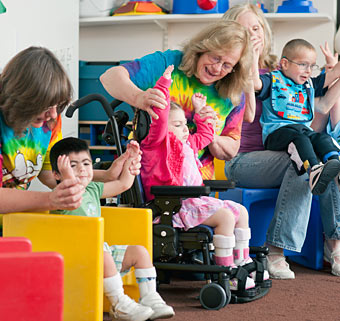 Task-oriented therapy approaches are used widely in school systems across the country. This is because students with disabilities learn and respond to their greatest potential when motor learning is incorporated into functional and meaningful tasks throughout the school day. One of the most successful and recognized task oriented methodologies is the MOVE Program. Within the MOVE curriculum, as in all task-oriented approaches, a student’s motor learning activities are incorporated in every activity from circle time, to classroom learning, to toileting and eating. However, helping a student complete these contextualized daily motor tasks and goals requires more time than just a therapist or teacher can provide during any given day. Instead, it takes an organized team effort.
Task-oriented therapy approaches are used widely in school systems across the country. This is because students with disabilities learn and respond to their greatest potential when motor learning is incorporated into functional and meaningful tasks throughout the school day. One of the most successful and recognized task oriented methodologies is the MOVE Program. Within the MOVE curriculum, as in all task-oriented approaches, a student’s motor learning activities are incorporated in every activity from circle time, to classroom learning, to toileting and eating. However, helping a student complete these contextualized daily motor tasks and goals requires more time than just a therapist or teacher can provide during any given day. Instead, it takes an organized team effort.
The Importance of Transdisciplinary Team Models
One of the main principles of a task-oriented approach is the emphasis on teamwork, especially the teaming of educators and therapists, to allow children to practice the same skills consistently throughout the school day. This concept is also referred to as the transdisciplinary model and involves an integrated therapy approach. Transdisciplinary teamwork is described as “committing oneself to teaching, learning and working with others across traditional disciplinary boundaries to better serve individuals with disabilities,” and integrated therapy is described as emphasizing “providing services within contexts considered meaningful or functional for an individual (student)” (Rainforth, 1997).
Role-Release and Teaching Motor Skills
In general, therapists need to practice “role-release” which in practical terms will mean teaching other staff to perform daily training of motor skills. Educators will need to see the value of motor skills as foundations for further learning in other areas, and they will need to see that motor skill training is not the exclusive domain of the physical and occupational therapists.
Enhancing Communication
Communication within the transdisciplinary team is key. One thing therapists can do to enhance communication is to use language that is understandable, not encumbered by too much medical jargon. The MOVE Curriculum is an example of a task-oriented approach that is written in language that parents, educators and therapists can all understand, with definitions given for special terminology.
How MOVE Helps Improve Teamwork
Within the MOVE Program, the team for each child includes at the minimum: a child, a parent, the educator and a therapist. Others may be closely involved and could also be on the team, including paraprofessionals, the physical education teacher or the nurse. This team has the main responsibility for implementing a task-oriented program for this student. In many educational settings, teachers and therapists are already used to working closely together on shared goals, so starting to work together on task-oriented goals is not difficult. In such settings, the benefits of a task-oriented approach based on the MOVE curriculum will be to give a structured way to select the highest priority skills to teach, to promote consistent learning opportunities throughout the day, and to allow documentation of progress in functional motor skills, even in small increments.
Reference
Rainforth B, York-Barr J. Collaborative Teams for Students with Severe Disabilities, 2nd ed. Baltimore: Paul H. Brookes; 1997.
Back to Top